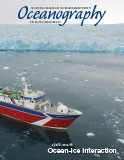Article Abstract
Melting of the Greenland Ice Sheet has the potential to raise sea level by 7.36 m and is already contributing to global sea level rise at a rate higher than 1 mm yr–1. Computer models are our best tools to make projections of the mass balance of Greenland over the next centuries, but these models rely on bed topography data that remain poorly constrained near glacier termini. Accurate bed topography in the vicinity of calving fronts is critical for numerical models, as the shapes of the glacier bed and of the nearby bathymetry control both the ocean circulation in the fjord and the stability and response of the ice sheet to climate warming. NASA’s Oceans Melting Greenland (OMG) mission is collecting bathymetry data along Greenland fjords at several glacier termini. Here, we show that these measurements are transforming our knowledge of fjord and glacier depths. Using a mass conservation approach, we combine OMG bathymetry with observations of ice velocity and thickness to produce estimates of bed depth and ice thickness across the ice-ocean boundary with unprecedented accuracy and reliability. Our results along the northwest coast of Greenland reveal complex structural features in bed elevation, such as valleys, ridges, bumps, and hollows. These features have important implications for both channeling ice flow toward the continental margin, and for controlling the amount of warm, salty Atlantic Water that reaches the glaciers.

